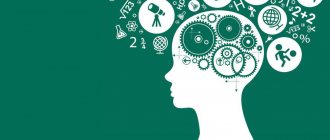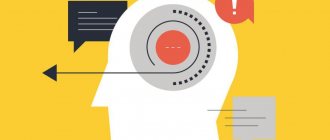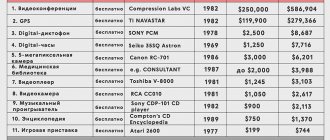Motor skill - automated influence on an external object with the help of movements in order to transform it, which has been repeatedly carried out previously.
Intellectual skill - automated techniques, ways to solve previously encountered mental problems.
Perceptual skill - automated sensory reflections of the properties and characteristics of well-known objects that have been repeatedly perceived before.
There are two fundamentally different types of skills: skills as primarily automatic actions, which involuntarily develop on the basis of instinctive motivation as a result of an unintentional combination of circumstances, and skills that are consciously developed in the learning process through deliberate reinforcement or automation of initially non-automatic actions.
The mechanism of primary automatic skills is conditioned reflexes; they are formed through the mechanism of temporary connections. Skills of the second type, secondarily automated actions, require, in addition to the mechanism of conditioned reflexes that is essential for their consolidation, also other “mechanisms” of an intellectual order - more or less generalized semantic connections.
The difference between these two types of skill is not only quantitative, but also qualitative, significant, fundamental. Skills of the second type are available only to humans (although humans have not only such consciously developed skills, but also involuntarily developed ones). The development of skills of the second type required fundamental general shifts in development: the transition from biological to historical development and the associated emergence of intellectual forms of cognition and conscious forms of behavior characteristic of humans.
Therefore, understanding and intelligence are involved in learning, and behaviorists have narrowed the range of memory phenomena to skills, and reduced learning to mechanical repetition and memorization, and in this they are WRONG.
Understanding or Intelligence
(from Latin intellectus - understanding, cognition) is an ability that unites all the cognitive abilities of an individual: sensation, perception, memory, representation, thinking, imagination/
Intelligence (from Latin intellectus - understanding, cognition) is the ability to carry out the process of cognition and to effectively solve problems, in particular when mastering a new range of life tasks.
2. Characteristics of skills and abilities.
Norman. Skill Stats:
1. Smoothness, ease of activity (for example, a professional solves a problem with apparent ease).
2. Automation. Disconnection of higher levels of consciousness (good typists do not know which finger in which situation they press the spacebar).
3. Mental effort decreases among professionals (Kahneman: correlation with pupil dilation).
4. The impact of stress is less among professionals. Since actions are automated and less mental effort is spent on them, stress does not arise.
5. Interpretation of the problem. Airplane, car, etc. for experienced professionals it is only a tool (“the pilot does not control the plane, but flies”).
The beauty of performing an activity. All these characteristics are harmoniously interconnected.
3. Learning and understanding. Norman.
▫ Learning without understanding: “learned idiots” can raise colossal numbers to powers, but they can’t do anything else.
▫ Understanding (or knowledge) without teaching: a strict instruction is given, it is understood normally, but under certain conditions it is still not followed (scuba divers do not dump ballast and drown, pilots do not lower their landing gear and crash).
4. Learning curve. — graphical representation of the learning process. It is assumed that its typical shape is a curve reflecting negative acceleration. This question remains unclear because there are so many variables that influence the course of learning that it is impossible to make any reliable generalizations.
Thorndike initially used the learning curve in his experiments. The progress of the experiments and the results were depicted graphically in the form of curves, where repeated samples were marked on the abscissa axis, and the time spent (in minutes) was marked on the ordinate axis.
Learning curve:
· falls if the measure is errors (i.e. if there are errors along the y axis and minutes along the ox axis, then since there will be fewer and fewer of them with the passage of time, the curve falls)
· increases if the measure is the number of actions per unit of time (the better we learn to do something, the faster we do it)
To obtain a complete learning curve, one must begin at the stage where the exercise is missing and continue until the subject exhausts himself.
The slope characterizes the speed of improvement (if fast - straight; usually - teeth). Horizontal sections of the curve:
1) Starting area. The subject's score at the very beginning was approximately zero. Example: juggling balls; Pavlov: A dog does not produce saliva immediately.
2) The final platform, a) good level (motivational limit); b) physiological limit.
3) Intermediate platform (plateau).
Perceptual skills
are automated mechanisms for perception, identification and classification of various information (stimuli, signals, irritants, situations, etc.).
Perceptual skills are mastered as if by themselves and are necessary, for example, for recognizing and distinguishing commands. At the very beginning of the training process, the puppy may confuse the execution of techniques and sit down on the “lie down” command, but over time this goes away. The dog learns to quickly and correctly recognize the signal command.
An example of the formation of a perceptual skill can also be a decrease in the indicative reaction during negative learning.
Under intellectual skills
imply automated algorithms, techniques and methods for solving problems that animals face in the process of life.
We can observe this behavior only when the dog is very interested and wants to think: during a hunt, when he wants to deceive us: not follow a command, steal something from the table, climb into the refrigerator, etc.
Motor or motor skills
– these are mastered and strengthened actions that provide optimal solutions to a motor task.
Motor skills not only include perceptual and intellectual skills, but are also regulated by them.
Under a high degree of mastery of action
imply its reliability, high speed of implementation, uniformity of reproducible elements of the action, independence of the action from external influence and the absence of conscious element-by-element regulation and control.
Ability and skill differ from each other in the degree of mastery of an action.
Under motor skill
refers to a relatively stable, but unstable to the action of disruptive factors (the appearance of a cat, a running person, etc.) degree of mastery of motor actions, which is characterized by conscious control of the elements of movement.
A skill is not reducible to a conditioned reflex, and it cannot be compared with a chain or set of conditioned reflexes. Any completed behavior of an animal (behavioral act) is much more complex and represents a set of inherited and acquired elements of behavior, the interaction of which occurs under the control and control of the animal’s intellectual apparatus.
The speed of skill formation is influenced by the animal’s ability to master the intended action, the type and level of motivation and the underlying need, the animal’s experience, the method of forming the action, the training regimen and the characteristics of reinforcement.
Stanley Coren
ranked dogs by intelligence level.
Published the book “The Intelligence of Dogs”
. It was not published in Russian.
Stanley Coren, How to Talk to a Dog.
E.N. Chukharev
- second general of cynology. He was a good organizer in the field of cynology. The first general was Medvedev.
The ability to learn in a breed is individual, because there is no selection for this quality.
The individual characteristics of a dog are expressed, first of all, in the psychophysiological properties of the animal: motivational-emotional characteristics (indifference), reactivity (ability to react quickly), excitability, lability of the central nervous system (quick transition from excitement to calmness and vice versa) - which have a significant impact on the ability to learning.
The theme of the relationship between teacher and student has ancient roots. Philosophers' thoughts on this topic are given in brief aphorisms: “when the student is ready, the teacher appears” and “the teaching about people is short, but knowledge is long.” Both statements imply a willingness to fully perceive the teacher or people (accurate interpretation of nonverbal communication). The development of perceptual abilities occurs according to a certain scenario. Taking them into account, as a rule, helps in many life situations to find relationships with others, and in cases of professional activity of specialists whose sphere of influence lies in the “person-to-person” area, it increases competence and success.
Meaning of the term
The word "perception" (percipere) of Latin origin literally translates as "perception". It has been known since Antiquity, but the issue of the development of perceptual abilities is being developed in detail by modern psychology. This fact does not mean that the study of the issue of completeness of perception was carried out fragmentarily. The problem of developing the perceptive abilities of an individual gained particular popularity thanks to Gottfried Leibniz. He meant by the term "perception" "vague impressions" as opposed to apperception - clear awareness of perception.
In modern psychology, perception appears along with such abilities as thinking, memory, attention, and has such properties as:
- objectivity;
- apperception;
- contextuality;
- meaningfulness;
- structure.
The scientific study of perception is carried out using empirical methods and modeling.
Properties of perception
Perception ensures the functioning of various mental processes.
The perception of an object as a specific image, regardless of its location, provides such a property of perception as objectivity.
Simultaneously with the perception of an image (natural or, for example, drawn), its properties are also reproduced in consciousness.
- Such a property as integrity is expressed in the fact that an object is recognized regardless of whether all its parts are present, whether they are distorted, or whether their location in the object is incorrect.
- The meaningfulness of perception during the normal functioning of the human psyche can be traced in the fact that the observed object is correlated with a specific class, category (classified).
- Observed objects (or situations) are perceived as unchanged, even if the conditions of their demonstration change. So, for example, by feeling an object in complete darkness, a person can correctly determine what it is and name its main characteristics. This property of perceptual activity is called constancy.
- This property of perception, such as structure, allows you to perceive the environment reliably, even if sensations are not connected. The expression “glass surface of a lake” paints a specific image of a perfectly smooth, shiny, bluish-greenish surface of a reservoir.
- The individual state of mind necessarily influences perception: stormy weather delights some, but frightens others immensely and creates a state of panic. This property of perception is called apperception.
- Perception depends on the conditions in which it occurs. The perception of the same thunderstorm in a real situation and, for example, when watching a movie, will occur differently, which is where such a property of perception as contextuality manifests itself.
Skill formation and development opportunities
All skills are formed in infancy and develop throughout almost a person’s life. Perceptual abilities are no exception. This is the most favorable period of a person’s life for the development of almost all abilities. Development occurs taking into account the characteristics of the individual development of the child.
In the period from 2 to 6 years, sensory-perceptual abilities are formed and developed. This state of affairs is due to the physiological development and improvement of the functioning of receptors. Based on this, two classifications of perceptual abilities have been adopted. This is perception by modality (visual, auditory, kinesthetic), as well as by the form of matter (space, movement, time).
Based on how these (and other) skills are formed by the age of seven, psychologists make a conclusion about readiness for learning. Sensory-perceptual abilities are basic, on the foundation of which more complex formations then appear (social-perceptual and perceptual-reflexive abilities). This happens mainly after the child identifies himself as an individual and begins to try on different social roles.
It should be noted that if for some organic reasons the process of formation of basic abilities is distorted (due to visual impairment, hearing, motor-skeletal system, other diseases), then more complex types may either not appear or appear in a distorted form. With normal development, perceptual-reflexive abilities, like others, can be developed and improved throughout life.
Basic Concepts
Perceptivity is a basic biological process of the human psyche. This function is acquired through the senses, which take part in the formation of a complete image of objects. Perception influences the analyzers through a series of sensations caused by perception.
It is also worth saying that perceptivity is a popular subject of study among psychologists. After all, such a reflection of reality allows us to form a full-fledged image of a certain phenomenon in the human mind.
Development programs and methods
All programs and methods for developing perceptual abilities are divided into three groups:
- complexes for children (and adults) with developmental problems;
- for children (and adults) with normal development;
- for the gifted.
They take into account not only intellectual, but also age and gender characteristics of the development of children, adolescents and adults. To determine the appropriate option, you need to read the explanatory note. It describes in detail the target audience, goals and objectives of the methodology or program.
Teenagers
With age, the role of accuracy and complexity of perception only increases, and the structure becomes more complex. Therefore, the leading activity of adolescents is not learning, but communication (a treasure trove for the development of perceptual abilities). Ignoring the importance of communication for teenagers by adults is unacceptable. This is the period of painstaking cutting of the “diamond” called “communication”. Thus, the teenager gets to know himself, takes an “inventory” of the inner world and completes the formation of the “I-concept”.
Social significance of the skill
A person gets to know himself, the people around him and the world through communication (verbal and non-verbal). On this basis, the socio-perceptual abilities of the individual are formed and developed. Understanding of the emotional experiences of the interlocutor is formed in preschoolers in the process of communication with significant adults and peers. This necessary component of communication is formed gradually, unconsciously, as an adaptation to the surrounding reality.
Communication is a process consisting of social perception, interaction (exchange of actions) and communication. The exclusion of any component leads to misunderstanding, misinterpretation of intentions, and distortion of contact between interlocutors. If adults consciously work on communication (exchange of information) and interaction almost all their lives, then with perception things are more complicated.
The formation and development of social-perceptual abilities is influenced by the child’s experience of family situations and associated emotional states. At the same time, the emotions shown by both parents have a great influence on the child. As a rule, the wider the children, the more successfully they recognize the emotional state of their interlocutor.
If it so happens that an adult’s perceptual abilities are not formed at an insufficient level and this fact is a significant obstacle to establishing and maintaining contacts, then a lot of time and effort will have to be devoted to eliminating the problem. At the moment, special computer programs have been created to help correct the perception of the interlocutor’s emotions based on facial expressions (more precisely, facial microexpressions).
The problems of interpreting a person’s emotional states are described in his books by a famous psychologist. Since the occurrence of such a problem can significantly ruin a person’s life, special courses on teaching communication, methods, lists of recommendations and exercises are being created.
The structure of perceptual action
Any process consists of individual operations - actions. The quality of the result depends on whether they are arranged in the correct sequence and performed without errors.
The process of perception includes a number of perceptual actions, this is due to the fact that a person needs:
- Consciously select information that is significant for him from the multitude that comes through sensory channels.
- Transform it in accordance with your own business objectives.
Perceptual action is several operations to transform sensory information.
Detection—detects the presence of a cognitive stimulus.
Discrimination - a perceptual standard is formed.
Next, the identification process takes place based on such actions as comparison and identification. The received image is compared with the one in memory and belongs to a certain class of objects, that is, it is categorized.
Mastering perceptual actions is a very difficult and lengthy process for a person, requiring special training.
Who needs to develop perceptual abilities and why?
People working in the service sector, education, and logistics communicate with clients, colleagues, students, and consumers every day. In their professional activities, developed perceptual abilities are the key to the successful implementation of goals and objectives. And not only on the professional path.
The developed perception of the interlocutor’s state also plays a huge role at the interpersonal level of communication. Often educated and intelligent people, who are unable to “read” a person on their own, suffer from distrust and suspicion of others, which interferes with their self-realization and pushes them to erroneous actions and conclusions. After all, a person gets to know himself through communication with other people. If communication is distorted, then the image of “I” undergoes corresponding changes.
It is important for every person to have a developed perception of an interlocutor, but the mechanisms and principles for using this ability will vary among all representatives of society.
What is the perceptual side of communication?
The perceptual side of communication (from the Latin perceptio - perception) is a special process that manifests itself in the course of interaction between individuals on the basis of natural communication, thanks to which participants in communication can correctly perceive each other’s actions and actions. In simple terms, within the framework of the perceptual side of communication, people “read” each other, which allows them to receive much more information and go beyond a simple verbal exchange.
Perception characterizes the perception of one person by another, when participants in communication have the opportunity to form an idea of themselves and their interlocutor. This became possible thanks to an understanding of goals and motives, which is no less important than the words spoken out loud. Within the framework of a dialogue, a person carries out an objective assessment of the interlocutor, whose internal qualities may not correspond to his own qualities. This format allows people to understand each other and identify opportunities and prospects for communication based on the coincidence of interests, views and worldview.
In psychology, perception is considered as a person’s ability to display at a cognitive level the objects of the surrounding world that he encounters throughout his life. Among the manifestations of perception are understanding and acceptance. This feature allows people to find a common language and build strong communication.
Parents
Perceptual pedagogical abilities are the perception and understanding of the state of the interlocutor without relying on verbal information (words). Consequently, every parent who worries about their children has this ability to one degree or another. There is a directly proportional relationship between “trusting” communication with a child and the formation of pedagogical perception in adults.
During early childhood, it is mom and dad who copy. Therefore, you can often hear the saying that children are a mirror of family relationships. Until the age of three, children unconsciously repeat gestures, words, intonations, and facial expressions after significant adults. Keeping this in mind, parents can fully demonstrate their pedagogical abilities in communicating with their child.
Perceptual teaching skills that help ensure lesson success. Related article
"Perceptual teaching abilities
helping to ensure the success of the lesson"
Practical pedagogical activity is only half built on rational technology. The other half of it is art. Pedagogical abilities are a personality quality. The main groups of abilities are distinguished:
* Organizational - the teacher’s ability to unite students, keep them busy, divide responsibilities, plan work, sum up.
* Didactic - skills to select and prepare educational material, clarity, equipment; present educational material in an accessible, clear and consistent manner; stimulate the development of cognitive interests.
*Perceptual - the ability to penetrate into the spiritual world of those being educated, objectively assess their emotional state, and identify mental characteristics.
*Suggestive abilities consist of an emotional-volitional influence on students.
*Research - the ability to understand and objectively evaluate pedagogical situations.
* Scientific-cognitive - the ability to assimilate new scientific knowledge in the chosen field.
Are all abilities equally important in the practical activities of a teacher? It turns out not. Leading abilities are:
*pedagogical vigilance
*didactic
*organizational.
The remaining abilities can be classified as auxiliary, accompanying. Let us dwell on one group of pedagogical abilities - perceptual abilities - the ability to identify the characteristics of the student’s psyche.
Some theorists suggest that human behavior, both normal and abnormal, is influenced by:
1.family environment
2.society
3.culture.
We are all part of the social framework of family, friends, acquaintances and even strangers; Some types of relationships with others in which we are involved can reinforce deviations in behavior and even cause them to arise.
Pedagogical activity is a specific activity, and its main feature is that the main subject of work here is the personality of another person. At the center of this activity is the emerging personality. Therefore, this person is especially sensitive to various social influences, especially vulnerable and less stable.
Obtaining adequate knowledge about the student’s personality is also important from another point of view. Studying the student’s personality seems necessary as a condition and method for providing feedback in the pedagogical process.
Psychodiagnostics of personality can help a teacher in solving most pedagogical problems. There is a whole package of tests that determine a person’s character type. The concept of “accentuation” was first introduced by the German psychiatrist and psychologist Leonhard. In our country, a different classification of accentuations has become widespread, which was proposed by the famous child psychiatrist, Professor Andrei Evgenievich Lichko.
Hyperthymic type.
High spirits, a thirst for novelty in everything - this determines all behavior. The most important feature of hyperthymic individuals is their great mobility, activity, tendency to mischief, restlessness, sociability, and talkativeness. All this manifests itself in the educational process in the form of restlessness and indiscipline. This behavior of hyperthyms very often causes displeasure and a sharp reaction from teachers.
The first signs of this type are already visible in elementary school. A high degree of activity is combined with a constant desire for leadership. Great activity is combined with promiscuity in choosing acquaintances. They easily adapt to unfamiliar surroundings, but do not tolerate loneliness, strict discipline, monotonous work requiring minute precision, and forced idleness. They tend to overestimate their capabilities and overly optimistic plans for the future. The desire of others to suppress their activity often leads to violent but short outbursts of irritation.
Particular attention should be paid to maintaining a distance sufficient for productive interaction. You can’t use cruelty, you need to interest (throw up new ideas)
Cycloid type.
It is characterized by a constant change of mood, independent of the person himself or the circumstances. The mood alternates between periods of mild depression and periods of hyperactivity for 10-15 days. This character type is three times more common in girls than in boys. In the subdepressive phase, performance decreases, interest in everything is lost, the teenager becomes a homebody and avoids company. Failures and even minor troubles are difficult to experience. Serious complaints, especially those that humiliate self-esteem, can lead to thoughts of one’s own inferiority and uselessness. Between phases there is often a fairly long period of “harmonious” behavior. The first signs of this type are around 12 years of age.
Recommendations for teachers: monitor mood, reduce demands during periods of depression.
Emotionally labile type.
The leading radical of this type is emotional lability. Changes in mood are frequent, but are associated with minor external stimuli and various life situations. Doesn't pretend to be a leader. He prefers to be around people who treat him well and are amorous. Labile adolescents have sincere and deep feelings and affections, especially for those individuals who themselves show love, attention and care. There is a great need for empathy. They subtly sense the attitude of others towards them, even with superficial contact. They have a hard time experiencing loss or emotional rejection from significant others.
Recommendations for teachers - praise, encouragement - this improves the mood and stimulates the teenager to activity.
Astheno-neurotic type.
The main features are increased fatigue and irritability. Slow performance, short peak and fast decline. Fatigue usually manifests itself during mental activities and in an environment of competition and rivalry. When tired, affective outbursts arise for insignificant reasons (these outbursts are physiological). They do not claim leadership, are easily subordinated, and are often influenced by others. Begins to appear at 9-11 years of age. Present throughout life. Regardless of their level of intelligence, they study averagely.
Recommendations for teachers: reduce the level of requirements (inflate grades), ask at 20-25 minutes of the lesson.
Psychasthenic type.
The main features are indecision, anxious suspiciousness (in the form of fears for the future of oneself and one’s loved ones) and a tendency to introspection. Character traits are revealed already in elementary school. Taking responsibility for yourself, and especially for others, can be the most difficult task. The type is consolidated at the age of 12-14 years, before this it is easy for doubts to arise. He does not pretend to be a leader, does not fall under influence, communicates among his own kind. Tend to study something in depth, independent, indecisive. They have correct self-esteem.
Recommendations for teachers: do not put them in a position of choice (you cannot teach), give only specific tasks. Use the penchant for deep learning, make it a think tank - let him study something and tell others.
Sensitive type.
Defined by timidity, vulnerability, indecision. Has a high level of demands on himself. Appears at 10-12-13 years, some signs even earlier. They are selective in communication, if they have become friends, they are loyal to their friendship, they are attached to loved ones, to their parents. They see many shortcomings in themselves, especially in the area of strong-willed qualities. Dissatisfaction with one's physical self (“body image”) is common. Reticence, timidity and shyness are especially evident among strangers and in unfamiliar surroundings. Even the most superficial contacts with strangers are difficult, but with those to whom they are accustomed, they are quite sociable. Extreme difficulties are caused by situations of negative evaluation or blame. Responsible, they study regardless of their level of intelligence, good. They prefer to live in illusions, in castles in the air. Sensitive people have a hard time with their parents' divorce. Considered as a betrayal.
Recommendations for teachers: You should not abruptly tear yourself out of your usual environment, even if you are going to go to college, it is advisable that your mother also go. An individual approach is required. You have to be sincere with the sensitive type. The most difficult type.
Schizoid type.
The main features are isolation and lack of sensitivity in the communication process, inability and reluctance to communicate, inability to understand other people's experiences, desires and thoughts of the partner. He doesn't care much about what's around him. Often sloppy, natural behavior is to read in a noisy, cheerful company. They formulate their conclusions in a complex, abstruse way, do not feel the pain of others and do not demand attention to themselves. They have weird hobbies. Character traits appear at 10-12 years of age.
Recommendations for teachers: you should leave the person alone (since the schizoid is self-sufficient) or become interested in him (which can be difficult)
Epileptoid type.
The main feature is a tendency to states of angry-melancholy mood, with constantly increasing irritation and a search for an object on which to take out evil. Characterized by affective explosiveness. These explosions are not only strong, but also long lasting. Love is almost always tinged with jealousy. An insatiable desire for leadership, they allow for a hierarchy of power, they achieve power by any means. They adapt well to conditions of a strict disciplinary regime, where through ostentatious performance in front of their superiors they strive to gain a position that gives them power over other teenagers. Characterized by meticulousness and strict adherence to rules (sometimes to the detriment of business)
Recommendations for teachers - you can give power, but delegate it in such a way that you can take it away (i.e. give little, otherwise you won’t take it away).
Hysterical type.
The desire to stand out, to be bright, the thirst for attention to oneself. The first signs appear quite early, even in kindergarten. They study better than anyone else or worst of everyone. There may be deceitful, unusual hobbies (no one else has this). A tendency towards posing, characterized by theatricality of experiences. A low ability to work hard is combined with high aspirations for a future profession. Among their peers they claim primacy or an exceptional position.
Recommendations for teachers - the more attention is paid to them, the more they want. Therefore, tasks with any creative options are needed. There are many hysterical actors among the actors.
Unstable type.
An irrepressible thirst for pleasure with an unwillingness to work, superficiality of hobbies. Signs of this type are already visible at 8-10 years of age. They study poorly and play truant. They easily obey and are influenced by the epileptoid type. Alcoholism quickly appears at 15-16 years of age (with early alcoholism). Under strict and continuous control, they reluctantly obey, but always look for an opportunity to shirk any work. Weak volitional component of personality. They are indifferent to their future, do not make plans, live in the present. Neglect quickly has a detrimental effect.
Recommendations for teachers: strict regulation of time for completing tasks, a “tight-knuckle” regime.
Conformal type.
The main feature is conformity: a pronounced desire to be “like everyone else.” This desire extends to everything - from the desire to dress like everyone else, to a strong dependence on the environment, judgments, attitudes and behavior. In a “good” environment they study well, try and work; in a “bad” environment they quickly learn its customs, habits, and behavior. They work most successfully when personal initiative is not required.
Recommendations for teachers: help change companies.
Summarizing all that has been said, we can obviously conclude that accentuation is not a pathology, but an extreme variant of the norm.
Used Books:
1. Podlasy I.P.” Pedagogy”, textbook part 1.
2. Rean A.A. "Psychology of personality studies."
3. Rean A.A. "Practical psychodiagnostics of personality."
4. Kjell A., Ziegler D. “Theories of Personality.”
Educators
In kindergarten, children gain experience communicating with peers and adults, who are sometimes ahead of their parents in importance. The team of the kindergarten group and parents is a fertile environment for the use of the teacher’s perceptual abilities.
The success of his professional activity directly depends on the ability to perceive in detail the state of his interlocutor and adequately interpret behavior and intentions. After all, raising a child occurs through direct communication with the teacher: in this case there are no secondary things, everything is important - facial expressions, intonation, gestures, diction, the distance between the interlocutors, the teacher’s competence in the issue under discussion, his personal position in relation to reality. After all, only the Personality (through full communication) educates the Personality.
The perceptual abilities of a teacher are the ability to perceive the student “whole”: with behavioral advantages and disadvantages, features of the development of the psychomotor sphere, communication and existing social experience of communication. The ability to “separate the wheat from the chaff,” nurture them and guide them along the path of harmonious development can be considered the talent of an educator who influences children by personal example purposefully and indirectly.
The nature of the perception process
The external environment and its individual objects and phenomena influence the senses through analyzers. Their complex interaction ensures the flow of information into the brain centers and its processing.
Complex analysis and synthesis of external data ensure the creation of a holistic image: external and hidden, internal properties and qualities of the object are determined. That is, a number of its characteristics are formed.
The process of perceiving the same object is unique, as is its mental image, since they depend on the individual mental and physiological characteristics of a person. Life principles, views, motives, interests, preferences as the results of upbringing and lifestyle certainly determine the assessment of the properties and qualities of an object. For example, the same work of art can be emotionally assessed by different observers as “strikingly beautiful” and… “disgusting.”
Teachers
A teacher's perceptual abilities are the ability to:
- perceive the student’s psychological state;
- keep the whole class and a specific student in sight at the same time;
- differentiate the characteristic features of a student from the manifestation of a momentary state;
- evaluate students’ activities based on the results of completion (positive, negative, neutral), voicing a comprehensive analysis.
It should be noted that the requirements for the skills, abilities and competence of a teacher vary depending on the field of activity: school, college, university. Different researchers classify teacher competencies in different ways. The conclusion about the importance of a person’s pedagogical orientation in activity remains unchanged (at a high level of development of general and special abilities).
Larisa Maksimovna Mitina in her research highlights the reflexive-perceptual abilities of a teacher and their components:
- pedagogical reflection;
- pedagogical tact;
- pedagogical orientation.
All of the above skills are components of pedagogical culture. Its structure includes significant qualities:
- professional and personal;
- professional knowledge;
- professional skills;
- active pedagogical position;
- experience of creative activity.
The value is the child - his development, learning, protection and support of dignity. The developed perceptual abilities of a teacher are the foundation for joint directed activities of teacher and student within the framework of pedagogical culture.
Children of preschool and primary school age
The formation and development of perceptual abilities begins in early childhood. This is due to the child’s adaptation to the world around him and the need for development (which does not exist without communication).
The Mowgli children serve as proof of this. Since they were placed in the environment of wolves, it was possible to survive only by becoming like them (copying their behavior). This “imitation” triggered more complex biological and psychological mechanisms, which ultimately did not allow children to become full-fledged people and shortened their lives to the lifespan of a wolf.
This example makes us think about the significance of the environment (emotional, material, sensory, etc.) in which children find themselves. After all, in childhood, perceptual abilities are the “engine” of a child’s development.
Sensation as a sensory-perceptual process
A person’s knowledge of the world around him begins with sensations, which are the beginning of this knowledge.
Finished works on a similar topic
Course work Sensory-perceptual process 410 ₽ Abstract Sensory-perceptual process 230 ₽ Test paper Sensory-perceptual process 220 ₽
Receive completed work or specialist advice on your educational project Find out the cost
Definition 3
Sensation is a mental cognitive process of reflecting individual properties and qualities of an object in the human mind.
Sensations directly affect the sense organs, through which information about the human environment enters the cerebral cortex. Thanks to sensations, the main external characteristics of an object are reflected - size, shape, color, sound, taste, muscle sensations, etc.
Sensations differ from each other in their quality, intensity, and sensual tone. The physiological basis of sensations is made up of analyzers and their activities. Analyzers consist of perceptive receptors, conducting receptors and central cortical sections of analyzers that process nerve signals coming from the receptors.
Sensations have certain properties - contrast, sensation thresholds, adaptation, sensitization, consistent images.
The contrast is that weak stimuli increase sensitivity, while strong ones decrease it. As for the threshold of sensations, the lower its value, the higher the sensitivity of this analyzer. The absolute threshold of sensations varies among people, and the upper threshold is the maximum value of the stimulus, above which the sensation is no longer perceived.
The discrimination threshold is the minimum difference in intensity of homogeneous stimuli that can be felt. With prolonged exposure to stimuli, the sensitivity of the analyzers may increase or decrease, which is an adaptation.
With increased excitability of the cerebral cortex, the sensitivity of the analyzers may increase under the influence of the activities of other analyzers. This phenomenon is called sensitization. For example, tasters have increased senses of smell and taste.
The continuation of the sensation can be observed when the action of the stimulus ceases, because the receptors are still in a state of excitement for some time - these are sequential images, for example, after a boat trip, a person will still feel rocking for some time.
Sensations based on the nature of the action of the stimulus on the receptors are:
- exteroceptive,
- interoceptive,
- proprioceptive.
Exteroceptive sensations include visual, auditory, taste, tactile and temperature sensations.
Interoreceptive sensations are sensations of pain, balance, acceleration, i.e. they reflect the state of the internal organs.
Proprioceptive sensations, or musculomotor sensations, reflect the movement of the human body. With their help, a person receives information about the position of the body in space, about contraction, stretching, and relaxation of muscles. These sensations are quite complex.
The role of perceptual abilities in the life of an adult
In the structure of general personality characteristics, perception is closely related to attention, thinking, cognition, sensation and imagination. In everyday life, people with developed perceptual abilities compare favorably with their antipodes. This is expressed in volume, accuracy, completeness and speed of perception, and the emotional coloring of the process. Such people are easy to train, adapt well to the environment, have a creative attitude to work, have their own point of view on current events, and value time.
Perhaps, knowing this pattern, employers, along with professional tests, would also conduct tests for the development of perceptual abilities. Perception also plays an important role in a person’s personal development. The solution to many problems lies in the sphere of completeness and accuracy of perception. That’s why there are sayings “the box just opened” or “it’s hard to find a black cat in a dark room if it’s not there.”
Components of the perceptual side of communication
The perceptual side includes a set of processes, among them the following can be distinguished:
- Assessing non-verbal signals transmitted by the interlocutor;
- Observation of behavioral attitudes;
- Formation, based on the information received, of ideas about the inner world of the interlocutor;
- Formation of the subject’s perception on an emotional level;
- Create effective and lasting communication.










